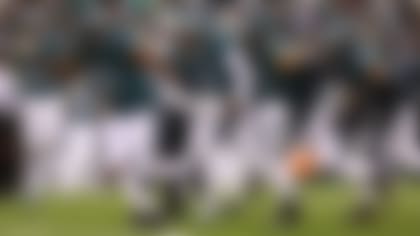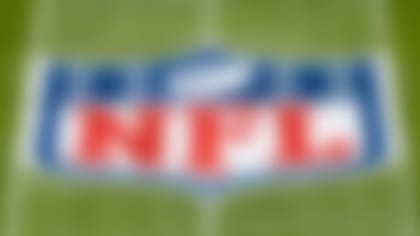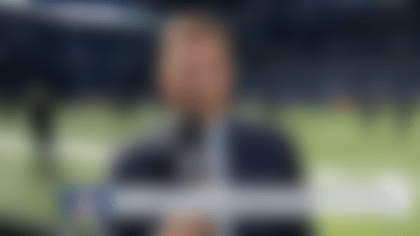September 14, 2016
Some of the greatest athletes in the world play football. Their ability to surprise and dazzle us with their talent—to lift our spirits—never ceases to amaze me. It's why nearly 200 million people call themselves fans of the National Football League. Because on any given game day, something incredible is going to happen.
Our game, of course, is a contact sport. Fans love to see the action on the field, including the big hits. While we can never completely eliminate the risk of injury, we are always striving to make the game safer—for our professional athletes down to young athletes first learning how to play.
We've made important progress in health and safety. We've made safety-related rules changes, encouraged advancements in equipment, improved medical protocols and care and changed the way we teach the game. Rightfully, much of the public discussion is about concussions—how they happen, how they can be prevented and treated and what is known about their long-term impact. That is what I want to focus on here today.
The NFL has been a leader on health and safety in many ways, and we've made some real strides in recent years. But when it comes to addressing head injuries in our game, I'm not satisfied, and neither are the owners of the NFL's 32 clubs. We can and will do better.
The NFL has been a leader on health and safety in many ways, and we’ve made some real strides in recent years. But when it comes to addressing head injuries in our game, I’m not satisfied, and neither are the owners of the NFL’s 32 clubs. We can and will do better.
Moving forward, our foremost priority will be to continually raise our standards and then surpass them. Let me tell you how.
Play Smart. Play Safe.
Today the National Football League is launching Play Smart. Play Safe., an initiative to drive progress in the prevention, diagnosis and treatment of head injuries, enhance medical protocols and further improve the way the game is taught and played by all who love it. It begins with a pledge of an additional $100 million in support for independent medical research and engineering advancements—building on the $100 million that the NFL and its partners are already spending on medical and neuroscience research—and a commitment to look at anything and everything to protect our players and make the game safer.
Our primary interest is in keeping our players and the public informed about these important health issues. As we gain new insights or discover new challenges, we will share them, so you will know them as well.
Our primary interest is in keeping our players and the public informed about these important health issues. As we gain new insights or discover new challenges, we will share them, so you will know them as well.
We are fortunate to have a prestigious group of independent neuroscientists serve on our Head, Neck and Spine Committee—volunteering their time to help us drive progress. They have done so, to no personal financial gain, because they want to make football and all sports safer and because they believe in the power to effect change through the NFL.
To better support their efforts and deliver on our new commitment, we have taken concrete steps to enhance our in-house expertise and better align our staff and outside advisors toward achieving our goal of a safer game.
We recently announced our commitment to hire a leading physician to serve as Chief Medical Officer of the NFL, working in the League office on a full-time basis and supported by appropriate medical and administrative staff. The Chief Medical Officer will work with each team's medical staff, the medical committees of the NFL and the NFL Players Association (NFLPA), as well as the broader scientific and medical communities, to help ensure that our clubs have access to the most up-to-date information, that our research funds are effectively advancing science and sports medicine and that our players and team staffs receive timely and comprehensive information on injury prevention, diagnosis and treatment.
Building on this, we are establishing an independent, scientific advisory board comprising leading doctors, scientists and clinicians to engage in a clear process to identify and support the most compelling proposals for scientific research into concussions, head injuries and their long-term effects.
This is an example of how we will let science lead the way. We know there is skepticism about our work in this area. That's why both the process and the results of our work will be shared with the medical community and the public at large.
We know there will be challenges. As we all learn more about concussions and take further steps to ensure our players are being properly cared for—and properly caring for themselves and their teammates—there may be an increase in reported concussions, as happened last season. So while no one wants to see concussion numbers rise, we firmly believe that more screening, self-reporting and collection of concussion data will inform increasingly reliable preventive measures. This is an important culture change for all of us.
To underscore how we will achieve our goal of making the game safer, our Play Smart. Play Safe. initiative will be organized under four pillars:
Protecting Players
Advanced Technology
Medical Research
Sharing Progress
Protecting Players
We commit to making changes on and off the field that will protect the health and safety of every player in the NFL.
We will continue to take a hard look at any aspect of the rules that can make the game safer for our players. We've made 42 rules changes since 2002 to protect our players, and we will make further changes as we study the effectiveness of those rules in preventing injuries and continue learning from the data.
For example, we've made changes to the kickoff rules that have made a positive impact, lowering the number of concussions sustained during kickoffs. But it is incumbent upon us to continue to track the data this season and study further options that may result in safer play.
We have made important changes to our practice guidelines and training methods to improve player health and safety outside of game day, including limiting contact in practice, which has led to a significant decrease in concussions. We will continue to look for ways to reduce the number of injuries even further.
We have made significant progress on several other fronts. We have transformed NFL sidelines by having 29 medical personnel at every game—including unaffiliated neurological consultants who assist in screening players for head injuries, and "eye in the sky" athletic trainers who serve as spotters and can call a medical timeout to stop the game if a player appears to be in need of medical treatment.
Earlier this summer, together with the NFLPA, we announced a policy to enforce our concussion protocol. We have worked hard to educate our teams and our players on the importance of following the protocol. But this latest agreement makes clear that there will be serious consequences for any team that fails to follow those best practices.
Earlier this summer, together with the NFLPA, we announced a policy to enforce our concussion protocol. We have worked hard to educate our teams and our players on the importance of following the protocol. But this latest agreement makes clear that there will be serious consequences for any team that fails to follow those best practices.
Another area of focus is working with the NFLPA to better educate our players on health and safety matters. From making more informed equipment decisions to increasing player knowledge about how to prevent, identify and treat injuries, we are constantly providing our players the best available information to protect themselves. Just last week, the NFLPA released a new concussion education video to players, which we were proud to collaborate on. We have also worked together on issues relating to proper maintenance and testing of playing fields and limited clubs to just 14 days of full-contact practice during the season.
All of this is important work. But we recognize it hasn't always been clear how connected these initiatives are to player health and safety. Moving forward, we will do a better job explaining all of these changes and the reasons behind them to our players and our fans.
For the benefit of our retired players, the NFL reached an historic settlement with NFL retirees and their families. The agreement will provide significant monetary awards to former players diagnosed with neurocognitive and neuromuscular impairments, without regard to whether the conditions are related to playing professional football.
We are eager to begin implementing the terms of this settlement and to continue our ongoing commitment to support former players through a variety of programs, from pension and other post-retirement financial benefits, to life insurance and savings plans, to health benefits and counseling services.
In our next labor negotiation, we will look for ways to make our commitments to retired players even more meaningful by focusing on emerging issues and considering ways in which our benefit programs can be reimagined to better serve the needs of our retired players and their families.
Advanced Technology
We commit to championing new developments in engineering, biomechanics, advanced sensors and material science that mitigate forces and better prevent against injuries in contact sports and recreational sports and for our military. In order to advance this effort, we are collaborating with the NFLPA and bringing in the world's foremost biomechanical engineers and material scientists as our advisors.
The NFL has allocated $60 million from the Play Smart. Play Safe. initiative to this effort, and—building on the successful model used in our Head Health Challenge competitions with GE—we will continue to crowdsource and support the best ideas from engineering experts around the world so that they can apply their expertise to these challenges.
We will continue to crowdsource and support the best ideas from engineering experts around the world so that they can apply their expertise to these challenges.
Consider football helmets, for example. Many biomechanical engineers believe that better helmets can be developed to do more to protect against concussions. The automobile industry, for one, has used modern tools and rich data analysis to advance car safety in significant ways.
A similar engineering approach has the potential to lead to improved football helmets in three to five years. Modern tools and the collection of data accurately representing on-field impacts will enable engineers to improve helmet performance. Once the problem can be measured, the engineering community can work on creating a better helmet. Our goal is to provide the resources and information to stimulate the marketplace to design solutions.
Another of our goals is to explore the concept of position-specific helmets. After all, we know from tracking game and injury data that linemen experience different impacts than a wide receiver or a defensive back. Yet their protective equipment is the same. We want engineers to use that information to consider design changes that address the specific needs of each position.
With so much innovation happening in our world, we believe progress can be made in this area.
For example, Quanterix, one of the companies that won the first GE-NFL Head Health Challenge, is developing a blood test to reveal a concussion diagnosis. This would be a major breakthrough. Once this or similar technology reaches the market, not only will this impact football and other sports, but public health will also benefit as doctors will have better tools for accurate diagnosis.
In the second GE-NFL-Under Armour Head Health Challenge, one of the finalists is Viconic, a company that is producing an under-layer for artificial turf fields that absorbs significantly more force than current fields. Viconic is an automobile safety company that used the challenge to start a new business line in sports safety. The company is in the final stages of testing the product before it can be made commercially available.
Medical Research
We commit to investing in and partnering with preeminent experts and institutions to advance progress in the prevention, diagnosis and treatment of head injuries.
We have already collaborated with some of the world's leading researchers and innovators in this area—even providing funding to some of our biggest critics. But this new initiative will take us far beyond our current commitments.
As mentioned earlier, our new scientific advisory board will be tasked with identifying new targets for the next wave of research. More than $40 million in funding has been allotted in the Play Smart. Play Safe. initiative for medical research over the next five years, primarily dedicated to neuroscience. This is in addition to the $30 million that the NFL has already committed to the National Institutes of Health.
The goal is to pursue scientific research to examine the long-term effects of concussion, the incidence and prevalence of chronic traumatic encephalopathy (CTE), and what can be done to improve long-term player health. This includes investing in research to explore new and effective ways to treat concussions.
The goal is to pursue scientific research to examine the long-term effects of concussion, the incidence and prevalence of chronic traumatic encephalopathy (CTE), and what can be done to improve long-term player health.
Along the way, we expect there will be scientific debate and disagreement on these topics. That means the scientific method is at work. Science moves forward by consensus, especially when smart and talented experts are committed to finding solutions.
We believe this research will have benefits far beyond football. The scientific community's understanding of the human body and brain has advanced so much in a generation—we are confident that by supporting this critical research, we can accelerate and make a meaningful contribution to progress. But ultimately, science will guide us on this journey.
Sharing Progress
We commit to sharing what we're learning across all levels of football—and to other sports and society at large.
We wholeheartedly believe in the value of young people playing football and other sports. We embrace the opportunity to be leaders in athletic safety.
We know that families across America grapple with whether to let their children play football. And we appreciate that there is real concern about tackle football.
We want to encourage the best minds to look at youth programs—not just football, but all sports. We will commit resources to fund new studies that examine how age, size, cognitive development and other elements should factor into youth athletics. Our goal will be to equip parents with the best available information to make decisions about their children's participation in football and other contact sports.
Our goal will be to equip parents with the best available information to make decisions about their children’s participation in football and other contact sports.
In the meantime, we will continue to share best practices, injury statistics, rules changes and recommendations about contact restrictions with partners at all levels—youth, high school and college. We will continue to talk about the importance of concussion education, hydration and the risks of heat, and the dangers of steroids and untested supplements.
We will continue to support USA Football. We believe youth football coaches are better informed than they've ever been about best practices, and we want to provide youth leagues with extra support.
For example, we know that having an athletic trainer on the sidelines at a high school game can be pivotal for how health and safety issues are handled. But many of our nation's schools lack the resources to pay for one. Accordingly, we plan to expand the size of our athletic trainer program, funding additional athletic trainers for high schools that need them. Our long-term goal is to raise awareness about the important role athletic trainers can play in high school athletics.
Finally, we will continue to work with colleges, which are experimenting with innovative practices designed to protect their athletes, and where many of our country's leading medical and scientific resources are devoting attention to issues of brain health. By working with and supporting their efforts, we can enhance the safety of football and other sports at both the collegiate and professional levels.
Long ago, before I was NFL Commissioner, I was a high school football player. I played safety for the Bronxville High School Broncos. Those were among the happiest days of my life.
The values I gained from that experience—grit, commitment to team, hard work and how to conduct oneself in both victory and defeat—are values I've applied throughout my adult life.
I often hear our former players express many of those same sentiments. But what I hear most frequently is that they miss the passion of the game and the bond of the team.
Playing in the NFL is an awesome achievement that few ever get to experience. No matter how long a player is in the League—whether it is one season or 20—it is to be celebrated. We want to make that experience even more fulfilling by doing everything we can to make the game safer.
By doing so, we will ensure that football remains the most beloved sport in America.
A central goal of this new effort is to help us understand more about the prevention, diagnosis, treatment and long-term impact of concussions and brain injury.
Until then, we will further strengthen our medical care, and we will enforce our concussion protocols.
We will continue to evolve the game and our rules.
We will work to bring together engineers toward the development of better equipment.
We will continue to fund independent scientific research.
And we will share what we learn along the way.
It all comes down to one overriding priority: the health, safety and well-being of every player.
It all comes down to one overriding priority: the health, safety and well-being of every player.













